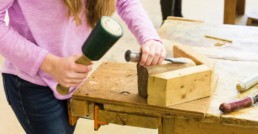Technology: When & How It’s Used At Susquehanna Waldorf School
At the Susquehanna Waldorf School (SWS), we believe in a mindful and purposeful approach to technology education. Rather than introducing screens at an early age, we prioritize experiential, hands-on learning that fosters deep thinking, creativity, and social connection. When students reach middle school, they engage with digital tools in a structured and developmentally appropriate way, ensuring they develop the skills necessary to be competent, responsible, and creative digital citizens.
Our approach aligns with both Waldorf education principles and modern scientific research, demonstrating that introducing technology at the right time, when students have developed strong foundational skills, leads to a more meaningful and productive relationship with digital tools. At SWS, students do not passively consume technology; they learn to use it as a tool for research, problem-solving, and ethical communication.
Why Timing Matters in Technology Education
Educational research shows that a strong foundation in critical thinking, problem-solving, and interpersonal communication enhances a student's ability to use technology effectively. Studies from the American Academy of Pediatrics and researchers like Dr. Dimitri Christakis suggest that early exposure to screens can impact attention spans and cognitive development. By focusing on immersive, hands-on learning in early childhood and elementary school, we prepare students to engage with digital tools thoughtfully and purposefully in middle school.
A study from UCLA further supports this approach, finding that children who spent time away from screens showed significant improvements in their ability to read human emotions—an essential skill for communication and collaboration. At SWS, we nurture these critical abilities before introducing technology in a structured curriculum that builds both technical competence and ethical awareness.
Middle School: A Purposeful Introduction to Technology
When students reach middle school, SWS gradually integrates technology through a comprehensive and carefully designed curriculum. Each grade level builds on the previous one, ensuring that students develop digital literacy in a way that enhances their learning while maintaining a balanced and healthy relationship with technology.
Sixth Grade: Establishing Digital Foundations
Students begin by developing keyboarding proficiency using the “Rapid Typing” program, which helps them build accuracy and speed. They also engage with Cyber Civics: Level 1 - Digital Citizenship, where they learn about online privacy, social media safety, ethical communication, and digital reputation. This foundation ensures that students approach technology with awareness and responsibility from the very start.
Curriculum for Keyboarding Skills:
“RAPID TYPING” PROGRAM
- The Introduction and Beginner courses help students to learn the position of keys on the keyboard. After completing this course, students will know which finger to use to hit each key without looking at the keyboard. The course also covers upper-case letters, special symbols, and the numeric pad.
- The Experienced course helps students to improve typing speed by memorizing frequently used syllables and words.
- The Advanced course helps students to perfect the skills acquired by typing an actual text.
Curriculum for Digital Literacy:
“CYBER CIVICS” LEVEL 1: DIGITAL CITIZENSHIP
- Investigating Technology
- Citizenship Today
- Digital Reputation
- Thinking Ethically Online
- Digital Communications
- Social Media Safety
- Cyberbullying
- Digital Drama
- Offline Bullying
- Hate Speech
- Online Privacy
- Presenting Yourself Online
Seventh Grade: Expanding Digital Competence
Building on sixth-grade skills, students advance their digital literacy with Cyber Civics: Level 2 - Information Literacy. They explore topics such as web searching, evaluating online sources, understanding algorithms, and managing personal information. Practical applications of technology are introduced through word processing, collaborative writing in Google Docs, and project creation using Google Classroom. By this stage, students integrate digital tools into their academic work while maintaining a thoughtful approach to their usage.
Curriculum for Digital Literacy:
“CYBER CIVICS” LEVEL 2: INFORMATION LITERACY
- Searching the Web
- Constructing Search Queries
- Reading a Results Page
- Personal Info Management
- Algorithms, Filter Bubbles
- Copyright, Plagiarism
- Searching the Web
- Constructing Search Queries
- Reading a Results Page
- Personal Info Management
- Algorithms, Filter Bubbles
- Copyright, Plagiarism
Eighth Grade: Mastering Media Literacy and Research Skills
Eighth-grade students engage with Cyber Civics: Level 3 - Media Literacy for Positive Participation, exploring topics such as misinformation, media representation, and the impact of artificial intelligence. They also refine their technical skills by incorporating research tools, spreadsheets, and multimedia applications into their academic projects. By the end of middle school, students are well-prepared to navigate the digital world with confidence, ethics, and creativity.
Curriculum for Digital Literacy:
“CYBER CIVICS” LEVEL 3: MEDIA LITERACY FOR POSITIVE PARTICIPATION
- Consumption vs. Production
- Multitasking
- Tech “Addiction”
- What's “News” Today?
- Detecting Misinformation
- Visual Literacy
- Media Representation
- Clickbait, Deepfakes
- Sexting, Sextortion
- Research Skills
- Artificial Intelligence
Technology as a Tool for Learning and Innovation
Rather than viewing technology as an end in itself, SWS sees it as a tool for deeper learning, problem-solving, and creative expression. Our middle school students are encouraged to explore programming, 3D printing, and robotics, providing them with opportunities to develop technical skills in a meaningful way.
Research from the Organisation for Economic Co-operation and Development (OECD) indicates that students who develop digital skills at a later stage, after establishing strong cognitive and social foundations, tend to perform better academically than those who are introduced to screens too early. This reinforces our belief that the right time and method of technology integration matter just as much as the tools themselves.
This balanced and developmentally informed approach helps Waldorf graduates thrive in a wide range of fields—including STEM. In fact, a 2017 study from the Research Institute for Waldorf Education found that 42% of Waldorf graduates pursue careers in science, mathematics, engineering, and technology. These numbers reflect the power of an education that prioritizes curiosity, deep thinking, and thoughtful engagement with tools and ideas.
A Balanced and Thoughtful Approach
The Susquehanna Waldorf School’s approach to technology is intentional, research-based, and developmentally appropriate. By introducing digital tools in middle school through a structured curriculum, we prepare students to be not just consumers of technology, but responsible, ethical, and creative digital citizens. Our students transition to high school with a deep foundation in critical thinking, collaboration, and innovation—empowered to use technology as a tool for meaningful learning and contribution to the world.
STEAM in Waldorf: Integrating Technology in a Human-Centered Way
In an increasingly digital world, the role of technology in education has sparked thoughtful discussions among educators and parents alike. At Susquehanna Waldorf School, we embrace STEAM (Science, Technology, Engineering, Arts, and Mathematics) education while staying true to our human-centered philosophy. Our approach fosters creativity, critical thinking, and ethical responsibility, ensuring students develop the skills they need for the future without losing their connection to humanity and the natural world.
In this post, we’ll explore how SWS integrates STEAM into its curriculum, balances hands-on learning with thoughtful technology use, and prepares students for a digitally interconnected future.
The Waldorf Philosophy on Technology
Waldorf Education prioritizes the developmental needs of children, emphasizing hands-on, experiential learning in the early years. Our intentional approach to technology ensures that students gain technical literacy at the appropriate time while first developing foundational skills like problem-solving, collaboration, and creativity.
- Why Limited Screen Time in Early Years?
The first stages of childhood are best served through active, imaginative play and physical exploration. Excessive screen time can hinder the development of critical motor and sensory skills. Instead, we offer students tactile, sensory-rich experiences that nurture their curiosity and ability to learn by doing. - A Thoughtful Introduction to Technology
As children grow older, technology is gradually and intentionally introduced in a way that complements their intellectual and emotional development. By the time students reach middle school, they are ready to engage with technology as a tool for learning, expression, and innovation.
Hands-On Learning: The Heart of STEAM in Waldorf
Hands-on learning is central to the Waldorf approach to STEAM education. Instead of relying solely on screens or simulations, we encourage students to engage directly with the world around them.
- Science
Students explore scientific principles through experiments, observation, and inquiry. For example, younger students might study the life cycle of a plant by growing one themselves, while older students engage in chemistry experiments to understand reactions firsthand. - Technology and Engineering
Engineering and design planning come alive in woodworking, metalworking, and other practical arts. By building with their hands, students develop spatial reasoning, problem-solving skills, and an appreciation for craftsmanship—skills that translate directly to technological fields. SWS students get to experience three years of physics, which is the study of the underlying laws and mechanisms explaining how the universe works. This education is hands-on and experience-centered. - Arts
The arts are seamlessly integrated into all subjects, fostering creativity and innovation. Students might illustrate scientific phenomena, create geometric art in math class, or use storytelling to present their understanding of historical events. - Mathematics
Math lessons go beyond rote memorization. Through real-world applications and artistic representation, students develop a deep and intuitive understanding of mathematical concepts.
Technology in Middle School: A Balanced Approach
By middle school, students at SWS begin engaging with technology in meaningful ways. Our Cyber Civics curriculum introduces digital literacy, teaching students how to use technology responsibly and ethically.
- What Is Cyber Civics?
Cyber Civics is a comprehensive program designed to prepare students for the complexities of the digital world. Topics include:- Digital citizenship: Understanding online behavior and responsibilities.
- Information literacy: Learning how to evaluate sources and discern credible information.
- Cyber safety: Navigating social media, privacy, and security with confidence.
- Project-Based Technology Integration
Students also use technology for projects that enhance their understanding of STEAM subjects. For example:- Designing and programming simple robots.
- Creating digital presentations or multimedia art.
- Using data analysis tools for math or science projects.
Through these activities, students see technology not as a distraction but as a powerful tool for creation and problem-solving.
Preparing Students for High School and Beyond
Susquehanna Waldorf School graduates are well-prepared to excel in high school STEAM programs and beyond. Our approach ensures that students not only gain technical proficiency but also develop the critical thinking and ethical framework needed to use technology responsibly.
- 21st-Century Skills
By integrating technology with hands-on learning and creative problem-solving, students develop the key skills sought in today’s world:- Collaboration
- Communication
- Adaptability
- Innovation
- A Human-Centered Mindset
Our graduates leave with more than technical knowledge—they carry a sense of purpose and responsibility, using technology to improve the world rather than simply consume it.
Why Waldorf STEAM Education Stands Out
The Waldorf approach to STEAM education is unique in its balance of tradition and innovation. By emphasizing hands-on learning and delaying screen time in early childhood, we ensure students build strong foundational skills. When technology is introduced, it’s done thoughtfully and intentionally, preparing students to navigate the digital age with confidence and integrity.
Experience STEAM at Susquehanna Waldorf School
Are you curious about how our STEAM program can inspire and empower your child? Schedule a tour to experience our classrooms in action, meet our dedicated educators, and see firsthand how Waldorf Education nurtures creativity, critical thinking, and a love of learning.
The Importance of Play in Early Childhood: Building Foundations for Lifelong Learning
In early childhood, the world is a playground of wonder, imagination, and discovery. At Susquehanna Waldorf School, we know that play is more than just a pastime—it’s the cornerstone of cognitive, social, and emotional development. Research consistently shows that play fosters critical brain development and lays the groundwork for lifelong learning and academic readiness.
In this post, we’ll explore why play is essential, how it shapes young minds, and how Waldorf Education creates an environment where meaningful play thrives.
Why Play Matters: A Research-Backed Perspective on Childhood Development
Play has been aptly described by child development expert Jean Piaget as “the work of childhood.” It is through play that children make sense of their world, engage with peers, and develop the foundational skills necessary for future success. Neuroscience reveals that during the early years of life, a child’s brain undergoes rapid development, creating millions of neural connections each second. Play serves as a critical catalyst for this growth.
The Key Benefits of Play
- Cognitive Development and Executive Functioning
Play engages the brain’s prefrontal cortex, which is responsible for executive functions like problem-solving, self-regulation, and decision-making. Activities such as imaginative role-play and building encourage children to think critically, experiment, and adapt to new challenges. These experiences also enhance memory, attention, and reasoning—essential skills for academic achievement. - Social-Emotional Growth
Play is a natural arena for developing emotional intelligence and social skills. Research highlights that children who engage in cooperative play learn empathy, negotiation, and conflict resolution. Whether they are taking turns, resolving disputes over rules, or comforting a friend, play helps children build the emotional resilience needed to navigate life’s complexities. - Physical Development
Active play strengthens motor skills, balance, and coordination while fostering healthy habits. Whether climbing, running, or exploring nature, children are building their physical strength and endurance. Moreover, physical play supports the development of proprioception (body awareness) and fine motor skills, which are critical for tasks like handwriting and tool use. - Emotional Regulation and Creativity
Pretend play allows children to process emotions, work through fears, and express themselves. For instance, when children pretend to be doctors or adventurers, they’re not only exploring their imaginations but also building coping mechanisms and self-confidence.
The Role of Play in Brain Development and Academic Readiness
Contrary to the misconception that play and academics are separate, research shows that they are deeply interconnected. Play is an essential vehicle for learning, as it strengthens the neural pathways required for academic success.
- Language Development: Through storytelling, singing, and role-playing, children enhance their vocabulary, narrative skills, and comprehension. These foundational skills are critical for literacy development.
- Mathematical Thinking: Sorting, stacking, and pattern-making during play introduce early math concepts like categorization, spatial awareness, and sequencing, forming a foundation for more complex reasoning.
- Executive Function and Focus: Unstructured play helps children practice self-control, adaptability, and sustained attention—skills that directly translate to classroom readiness.
- Creativity and Problem-Solving: Open-ended play encourages divergent thinking, which is essential for innovation and academic inquiry.
In essence, play cultivates the curiosity, perseverance, and joy that drive a lifelong love of learning.
Play in the Waldorf Early Childhood Classroom
At Susquehanna Waldorf School, play is a cornerstone of our early childhood education. We recognize that every moment of play is an opportunity for growth, creativity, and connection. Our classrooms are designed to nurture the whole child—mind, body, and spirit.
- Imaginative Play: Simple, open-ended materials like wooden blocks, silks, and natural objects spark creativity and storytelling, helping children build narrative skills and problem-solving abilities.
- Outdoor Exploration: Time in nature is integral to our curriculum. Activities like climbing, gardening, and observing seasonal changes foster physical development, environmental stewardship, and a sense of wonder.
- Rhythm and Routine: Predictable rhythms provide security and balance, while integrating play into daily activities like baking, singing, and crafting nurtures a harmonious learning environment.
- Community Building: Mixed-age classrooms encourage mentoring and collaboration. Older children model behavior and skills, while younger ones learn by observing and engaging in play.
How Parents Can Support Play at Home
Parents are a child’s first teachers, and creating an environment that values play can significantly enhance a child’s growth. Here’s how you can nurture meaningful play:
- Provide Open-Ended Materials: Toys that inspire creativity, like building blocks, art supplies, and natural items, encourage exploration and imagination.
- Emphasize Outdoor Play: Nature provides endless opportunities for discovery and physical activity. Regular outdoor time fosters resilience and curiosity.
- Encourage Unstructured Play: Avoid over-scheduling. Allow children to engage in free play where they lead the activities.
- Model Playful Curiosity: Join in your child’s play. Build forts, act out stories, or create art together to strengthen bonds and model enthusiasm for exploration.
The Lifelong Impact of Play
At Susquehanna Waldorf School, we believe that the gift of play is the greatest foundation we can provide for a child’s future. Through play, children learn to navigate the world with confidence, creativity, and joy. They develop not only the skills needed for academic success but also the emotional resilience and curiosity that make life meaningful.
As we celebrate the wonder of childhood, let us recommit to creating environments—both at home and at school—where children can play, learn, and thrive. Together, we can build a foundation for lifelong learning and fulfillment.
Cultivating Connection: Social-Emotional Learning in Waldorf Education at Susquehanna Waldorf School
At Susquehanna Waldorf School, nestled along the Susquehanna River between Lancaster and York County, we are proud to nurture students from Pre-K through 8th grade with an education that goes beyond academics. We prepare children not only for intellectual growth but also for life itself. Social-emotional learning (SEL) lies at the heart of this mission, as it fosters a sense of self-awareness, emotional intelligence, and meaningful relationships—key pillars of a fulfilling life.
What Makes Social-Emotional Learning Unique in Waldorf Schools?
Waldorf education views children as whole beings—body, mind, and spirit. In this holistic approach, SEL is seamlessly woven into daily life, rhythms, and curricula, helping children connect with themselves, their peers, and the world around them. Here at Susquehanna Waldorf School, this integration is intentional, immersive, and inspiring.
1. Nurturing Emotional Intelligence Through Artistic Expression
The arts are central to the Waldorf curriculum, providing a natural avenue for children to explore and express their emotions. Painting, music, drama, and storytelling create a safe and structured space for students to process feelings and empathize with others. For instance, through storytelling in the younger grades, children are introduced to archetypes and characters that teach compassion, resilience, and moral courage.
2. Fostering Community Through Collaborative Learning
Our multi-faceted curriculum encourages cooperation and empathy through group projects, class plays, and shared responsibilities. These activities teach students to listen to diverse perspectives, resolve conflicts, and work as a team. This focus on collaboration builds strong classroom communities where every child feels valued and respected.
3. Building Emotional Resilience Through Rhythm and Routine
Daily rhythms provide a comforting structure that supports emotional regulation. Seasonal festivals, morning verses, and predictable classroom routines help children feel grounded and secure. This stability allows them to process challenges and adapt with resilience, a skill essential for navigating life's ups and downs.
How SEL Impacts Our Students
The SEL practices at Susquehanna Waldorf School create a ripple effect that touches every aspect of a child’s life. Here’s how our students benefit:
- Self-Awareness and Confidence: From the earliest grades, students are encouraged to reflect on their feelings and experiences. This develops a strong sense of self and the confidence to face challenges.
- Empathy and Kindness: Through the arts and storytelling, children learn to step into others' shoes, fostering empathy and compassion.
- Conflict Resolution Skills: When challenges arise, teachers guide students to resolve conflicts respectfully, equipping them with tools for healthy communication.
- Lifelong Connection: Alumni often report that the relationships formed during their Waldorf education remain a source of strength and inspiration throughout their lives.
“It’s so important to empower students to solve problems and provide safe opportunities for them to practice problem-solving skills. All students at SWS are provided a safe and welcoming environment to enrich their social-emotional learning. Social-emotional learning provides students with strategies that benefit their academics, mental wellness, and social relationships.” Erica Ware, IU3 Guidance Counselor
A Partnership with Families
At Susquehanna Waldorf School, we recognize that social-emotional growth is most successful when it’s a partnership between school and home. We offer workshops, “family hangs”, and resources to help families support their children’s emotional well-being. Together, we strive to create a harmonious environment that reflects the values of kindness, community, and connection.
Social-emotional learning is not just a program at Susquehanna Waldorf School; it’s a way of life. By cultivating emotional intelligence and fostering meaningful relationships, we prepare our students to become thoughtful, compassionate, and resilient individuals. Whether they’re navigating the playground in Kindergarten or preparing for high school in eighth grade, our students possess the skills they need to thrive, both now and in the future.
If you’d like to learn more about how Waldorf education integrates SEL into every aspect of learning, we invite you to visit Susquehanna Waldorf School. Experience firsthand how our vibrant community nurtures the heart, head, and hands of each child.
The Magic of Seasonal Festivals: Celebrating Together at Susquehanna Waldorf School
At Susquehanna Waldorf School (SWS), festivals are a cherished part of the educational journey, bringing together students, teachers, families, and the wider community. These seasonal celebrations are far more than just school events; they are a foundational part of Waldorf Education, fostering a deep connection to nature, culture, and each other.
In this post, we’ll explore the role of festivals, the values they instill in our students, and how they strengthen the sense of belonging that defines the SWS experience.
Why Festivals Matter in Waldorf Education
Festivals are woven into the fabric of Waldorf schools around the world. They mark the rhythms of the year, giving students a sense of time rooted in nature’s cycles. These celebrations help children experience the changing seasons in a meaningful way.
Festivals at Susquehanna Waldorf School are about more than just the passing of time. They also reflect the values that Waldorf Education seeks to cultivate:
- Connection to Nature: Whether it’s the autumnal Michaelmas Festival, the Winter Spiral of Light, or the joyous celebration of Spring’s return on May Day, each festival is a reminder of our place within the natural world. Students develop a reverence for nature as they celebrate the changing seasons and witness the transitions of growth to harvest, darkness to light, and rest to renewal.
- Cultural Awareness: Many Waldorf festivals draw from a rich tapestry of cultural traditions, giving students a sense of the global community. For example, during our lantern walk in Autumn, some classes celebrate Diwali and learn the stories of Indian traditions during this time. We also hold festivals for Lunar New Year and Dios de los Muertos in our language classes.
- Gratitude and Reflection: Festivals are a time for pausing and reflecting on the world around us. Whether through songs, stories, or shared activities, these celebrations instill a sense of gratitude for the blessings of the earth and the joys of human connection.
- Community Spirit: Perhaps one of the most treasured aspects of the festivals at SWS is the way they bring our community together. Festivals offer opportunities for students, teachers, and families to connect on a deeper level, fostering a sense of belonging that extends beyond the classroom.
Seasonal Festivals at SWS: A Year in Celebration
Here’s a glimpse into some of the festivals we celebrate at Susquehanna Waldorf School and what they mean to our community.
Michaelmas (Autumn)
Celebrated in late September/early October
Michaelmas marks the end of the harvest season and the beginning of autumn. Rooted in the legend of St. Michael, the festival symbolizes inner courage and strength as we face the darker days ahead. At SWS, this is a time when students may participate in outdoor games, theatrical performances, and songs that reflect themes of bravery, light, and perseverance.
The heart of the celebration is our annual community Michaelmas Festival, where students take part in plays and reenactments of the story of St. George and the Dragon—a metaphor for confronting challenges with courage and resolve. Students participate in a series of developmentally appropriate feats of courage. The festival ends with the time-honored students vs. teachers and parents tug-of-war.
Martinmas & Lantern Walk (Late Autumn)
Celebrated in November
Martinmas, a festival honoring St. Martin, highlights themes of kindness, compassion, and sharing. At the heart of this celebration is the story of St. Martin, a Roman soldier who cut his cloak in half on a cold winter night to share it with a beggar. At SWS, we bring this story to life by encouraging students to perform acts of kindness and reflect on how they can share their own "light" with others.
The festival includes a Lantern Walk, during which students carry handmade lanterns and walk together through the darkening paths, singing songs of light and hope. The glowing lanterns symbolize the warmth and light we can share, even in the darkest of times.
Spiral of Light (December)
Celebrated in early December
The Winter Spiral of Light is a beloved tradition that helps us all pause and reflect as the days grow shorter. Taking place in early December, this peaceful ceremony represents our journey of navigating darkness with light. In a quiet, reverent atmosphere, students walk through a spiral of evergreens, lighting candles that symbolize hope and warmth in the darkest days of the year.
This festival is a powerful reminder of the inner light we all carry, a source of strength during the winter season. Parents and families are often invited to witness this touching ceremony, deepening the sense of connection among the community.
May Day (Spring)
Celebrated in early May
As spring blossoms, the SWS community comes together to celebrate May Day, a festival bursting with joy, color, and music. Students dance around the Maypole, weaving ribbons in beautiful patterns, symbolizing the unity and renewal that come with the arrival of spring.
This celebration is a visual delight, with students wearing crowns of fresh flowers and families gathering to enjoy outdoor games, picnics, and performances. May Day embodies the spirit of community, creativity, and the natural beauty that Waldorf students are encouraged to appreciate.
The Power of Festivals in a Child’s Development
These festivals are more than just moments of celebration—they offer children valuable lessons that will stay with them for life. Here’s how festivals contribute to a child’s personal and social development:
- Building Traditions: Traditions create a sense of continuity and security in a child’s life. As students participate in these festivals year after year, they build lasting memories and develop an appreciation for the rhythms of life.
- Emotional Intelligence: Festivals often include moments of reflection and gratitude, helping students cultivate emotional intelligence. Learning to express gratitude, appreciate beauty, and reflect on deeper meanings helps children develop empathy and emotional maturity.
- Creativity and Imagination: Preparing for each festival involves artistic activities like crafting, painting, singing, and storytelling. These experiences also nurture creativity and imagination, which are core principles of Waldorf Education.
- Community Engagement: Festivals bring people together, reinforcing the importance of community and collaboration. By participating in group activities and performances, children learn to value teamwork and experience the joy of shared experiences.
How Families Can Participate in SWS Festivals
At Susquehanna Waldorf School, festivals are not just for students—they are for the whole community. Here are some ways parents and families can get involved:
- Attend Festivals Together: Families are always encouraged to participate in our seasonal festivals, whether by attending performances, helping with decorations, or joining in community activities.
- Support Creative Preparations: In the weeks before a festival, parents can encourage their children’s creativity at home. This might mean helping to gather materials for a lantern or working on a seasonal craft together.
- Reflect on the Meaning of the Festival: Take time as a family to discuss the deeper meaning of each festival. Whether it’s courage, light, or renewal, talking about these themes can help children form a personal connection to the celebrations.
- Celebrate At Home: Whether crafting, cooking, decorating, or storytelling, there are many ways to incorporate the seasons into your home.
Looking Forward to the Next Festival
As we approach the season of shorter daylight, we invite you to join us in kindling your inner light by participating in the Lantern Walk and Spiral of Light, two of the most reflective and cherished festivals at SWS. Keep an eye on our calendar for dates and details.
We hope you’ll join us in celebrating the magic of these festivals as we nurture the hearts, minds, and spirits of our students together.
The Role of Arts in Waldorf Education Nurtures Creativity and Holistic Development
At Susquehanna Waldorf School, the arts are not just an addition to the curriculum—they are a part of the learning experience. From painting and drawing to music and drama, the arts play a crucial role in nurturing creativity, fostering emotional expression, and supporting the holistic development of our students.
Why Arts Are Central to Waldorf Education
In Waldorf Education, the arts are considered as important as academic subjects like math and language arts. This stems from the core value that true education engages the whole child—head, heart, and hands. Here’s how the arts support a balanced education:
- Engaging Imagination: The arts encourage students to explore their imagination and express themselves creatively. Whether it’s through drawing, storytelling, or playing a musical instrument, artistic activities allow children to connect with their inner world and bring their ideas to life.
- Developing Emotional Intelligence: Artistic expression helps students understand and process their emotions. Through art, children can explore complex feelings, develop empathy, and build a strong sense of self-awareness. This emotional intelligence is vital for forming healthy relationships and navigating life’s challenges.
- Enhancing Academic Learning: The arts are deeply integrated into the academic curriculum at Susquehanna Waldorf School. For example, students might create watercolor paintings to illustrate a story from history or use modeling clay to understand geometric forms. This artistic approach not only makes learning more engaging but also helps students internalize and remember complex concepts.
- Fostering Creativity and Innovation: By regularly engaging in artistic activities, students learn to think creatively and approach problems from different angles. This ability to innovate and think outside the box is a skill that will serve them well throughout their lives, no matter what path they choose.
Arts in Action: A Day in the Life at SWS
Let’s take a closer look at how the arts are woven into the daily life of students at Susquehanna Waldorf School.
- Morning Lesson: The day begins with the Morning Lesson, where arts and academics are seamlessly integrated. For instance, during an ancient civilization lesson, students might illustrate Egyptian hieroglyphs or craft clay models of ancient artifacts. This hands-on approach deepens their understanding and makes the material come alive.
- Art Lessons: Students participate in art lessons where they explore various mediums such as watercolor, charcoal, and pastels. These classes are not just about learning techniques—they are about fostering a deep connection to the creative process.
- Music and Movement: Music is a daily activity at SWS. From learning to play the recorder to singing in a choir, students experience the joy of making music together. Additionally, Eurythmy, a form of expressive movement unique to Waldorf schools, helps students connect with rhythm, language, and emotion through physical movement.
- Seasonal Festivals and Performances: Throughout the year, students participate in seasonal festivals that often include dramatic performances, musical presentations, and visual art displays. These events showcase the students' creativity and provide an opportunity for the whole school community to come together.
The Lasting Impact of Arts Education
The benefits of an arts-rich education extend far beyond the classroom. Waldorf graduates are often noted for their creative thinking, adaptability, and strong sense of purpose. The confidence and self-expression nurtured through the arts at Susquehanna Waldorf School empower students to take on challenges and pursue their passions with enthusiasm.
One of our alum, Dakota Lehman, reflects on the role of the arts in her education: “Making art in my early years helped me to understand in high school and college that others may learn in different ways. I was given the tools to be able to adjust and adapt to learning in different environments and I wanted to be able to give the experience of using art mediums in different ways to others. I now work with children, and especially with the influence of technology, it’s important to have other options as new ways to process and explore life.”
How You Can Support Your Child’s Artistic Development at Home
As a parent, there are many ways you can support your child’s artistic development:
- Create an Art-Friendly Space: Set up a space at home where your child can draw, paint, or work on crafts. Having easy access to art supplies encourages spontaneous creativity.
- Encourage Exploration: Allow your child to experiment with different art forms. Whether it’s painting, sculpting, or playing an instrument, giving them the freedom to explore different mediums will help them discover their passions.
- Celebrate Creativity: Display your child’s artwork at home and celebrate their creative achievements. This will not only boost their confidence but also reinforce the value of artistic expression.
- Engage with the School Community: Attend school performances, art exhibitions, and festivals to show your support for the arts at Susquehanna Waldorf School. These events are a wonderful way to connect with other parents and celebrate the students' creative talents.
Looking Forward
As we continue through the school year, the arts will remain a vibrant and essential part of our student’s education at Susquehanna Waldorf School. We invite you to explore the many ways in which creativity is fostered in our community and to support your child’s artistic journey both at school and at home.
If you are interested in an art-integrated independent school in Lancaster / York for your child, please contact our admissions director, Liz Pargament, or sign up for a tour here.
Welcome SWS 2024-2025: What to Expect in the New School Year
As the summer days begin to fade and we prepare to welcome the new school year at Susquehanna Waldorf School (SWS), we are excited to embark on another journey of growth, learning, and community. Whether you are new to Waldorf Education or a returning family, this time of year is filled with anticipation and energy. To help you and your child transition smoothly into the new school year, we’ve put together this guide on what to expect and how to make the most of your experience.
Understanding the Waldorf Approach
Waldorf Education is unique in its holistic approach to learning, focusing on nurturing the intellectual, artistic, and practical skills of each student. At Susquehanna Waldorf School, our curriculum is designed to meet the developmental needs of children at every stage. From early childhood through the grades, our students engage in a rich variety of activities that foster creativity, critical thinking, and social responsibility.
Key Elements of the Waldorf Curriculum:
- Rhythm and Routine: Each day is structured around a rhythm that includes a balance of academic work, artistic activities, and outdoor play. This rhythm helps children feel secure and supports their natural development.
- Morning Lesson Blocks: The school day begins with a two-hour Morning Lesson, where students immerse themselves in a single subject for several weeks. This immersion into learning allows for a more profound understanding and retention of material.
- Artistic Integration: Art, music, world languages, and movement are woven into the curriculum, helping to engage multiple senses and deepen learning. Whether through painting, sculpting, or playing instruments, students explore and express themselves creatively every day.
- Outdoor Learning: Nature plays a central role in Waldorf Education. Our students spend ample time outdoors, learning through exploration and hands-on experiences. This connection to nature fosters environmental stewardship and a deep appreciation for the world around us.
Preparing for the School Year
To ensure a smooth transition into the school year, here are a few tips for both new and returning families:
- Familiarize Yourself with School Routines: Review the daily and weekly schedules with your child so they know what to expect. Understanding the rhythm of the school day can help ease first-day jitters.
- Prepare School Supplies: While Waldorf schools focus on simple, natural materials, make sure your child has all the necessary supplies. Your class teacher will provide a list of items needed for the year.
- Establish a Home Rhythm: Creating a daily routine at home that aligns with the school’s rhythm can be helpful. Consistent bedtimes, meal times, and quiet times for reading or creative play can make the school day more manageable. This is also a great time to limit screens to minimal use only during weekends.
- Stay Connected with the Community: Engage with other parents, attend school events like our Playground Cleanup, and connect as a class. Building a strong connection with the school community enhances your child’s experience and provides you with support and resources. The Parent Guild is the collective parent body of Susquehanna Waldorf School and meets once a month on Sunday from 10:00 am - 12:00 pm. This year’s meetings are on: 8/18, 9/15, 10/20, 11/10, 12/15, 1/12, 2/9, 3/16, 4/27, 5/18
Upcoming Events and Important Dates
As we kick off the school year, here are some important dates to mark on your calendar:
- First Day of School For Grades: September 3rd
- Rose Ceremony & Welcome Back Tea: September 3rd, 8:15 am - 10:00 am
- Early Childhood Cubby Day: September 3rd
- First Day of School For Early Childhood: September 4th
- Back-to-School Brunch: September 14th from 10:00 am - 12:00 pm
- Michaelmas Festival & 1st Family Hang: September 27th from 1:00 pm - 5:00 pm
- David Sewell McCann Workshop: September 28th from 9:00 am - 1:00 pm
These events offer wonderful opportunities to get involved and connect with other families and faculty members.
See the full calendar of events here.
Looking Ahead
The start of a new school year is always an exciting time, filled with the promise of new experiences and growth. At Susquehanna Waldorf School, we are committed to supporting your child’s educational journey every step of the way. We look forward to a year filled with creativity, exploration, and community.
Welcome back, and let’s make this school year a memorable one!
Are Waldorf Schools Art Schools?
The Waldorf curriculum has been intentionally designed to provide a well-rounded education. Students engage in a wide range of subjects, including mathematics, science, language arts, history, and geography. One aspect that sets Waldorf Education apart, however, is its commitment to integrating artistic activities into every aspect of learning. This has led to the misconception that Waldorf schools are only for “artistic students” or are “art schools.” However, the Waldorf curriculum does not include art classes in the manner of most other schools; rather, it's about enlivening all subjects with artistic means to create joyful, rich, and engaging learning experiences for students.
In Waldorf Education, art is not a separate or optional activity; it is an essential tool for teaching and learning. Through artistic activities, such as drawing, painting, music, and theater, students actively engage with academic subjects in a way that makes learning come alive. For example, when studying history, students might create historical plays or artistic projects that allow them to immerse themselves in the time period being studied. This hands-on approach not only deepens their understanding but also makes the learning experience more enjoyable.
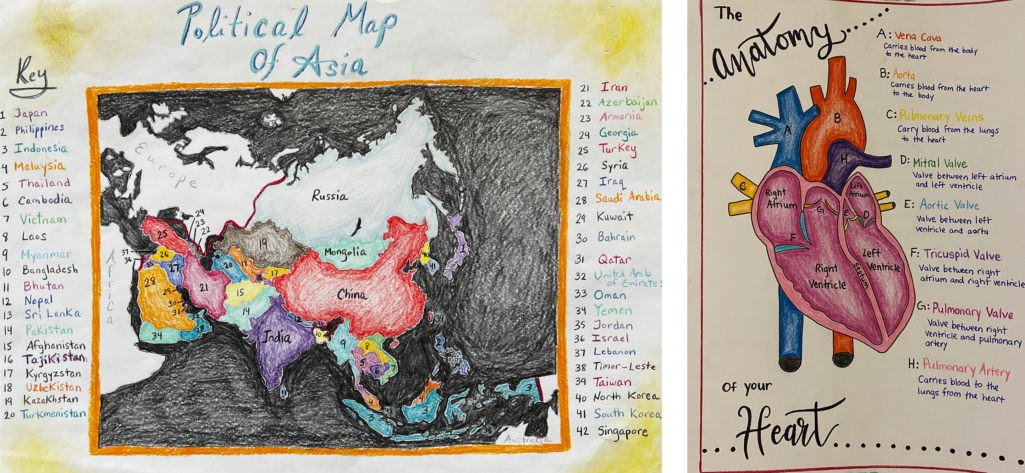
Art in Waldorf Education plays a crucial role in fostering creativity and imagination. By encouraging students to express themselves through various artistic media, they develop the ability to think outside the box, problem-solve, and explore their individuality. This creative spirit extends beyond the art studio and into all aspects of their lives. Students learn to approach challenges with innovative solutions, and they are better prepared for a world that increasingly requires adaptability and creative thinking.
Critics might argue that an emphasis on art could lead to less rigor. However, this is far from true in Waldorf Education. The curriculum is academically challenging and aims to prepare students for a broad range of future endeavors. An artistic approach enhances academic learning by making complex concepts more accessible and engaging. For example, in mathematics, students might use artistic patterns and designs to better understand abstract concepts. In science, they might draw and label intricate diagrams to understand biological processes. The artistic elements provide a concrete and imaginative connection to abstract ideas, making them easier to grasp and recall.
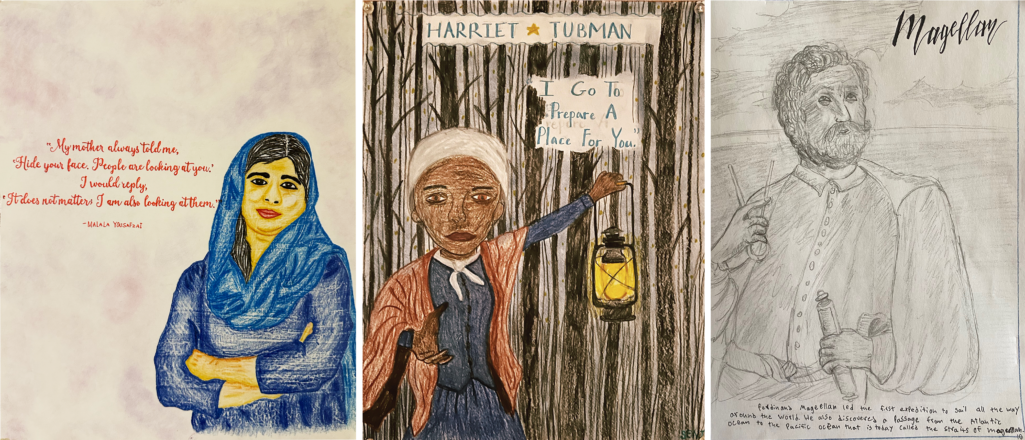
Susquehanna Waldorf School’s strong commitment to academic excellence and deep appreciation for the role of art in learning are perfectly paired. This results in a nurturing environment where students flourish academically and artistically.
The role of art in Waldorf Education is not merely an add-on or extracurricular activity; it is a fundamental hallmark of the curriculum. By incorporating art into all subjects, we empower students to become creative, critical thinkers while maintaining a rigorous academic program. In this holistic approach to education, the arts are not just a means of expression but a powerful tool for unlocking the full potential of each student. Waldorf Education serves as a reminder that nurturing a child's creativity and imagination is just as important as developing their academic abilities, and the two are beautifully intertwined on the path of learning.
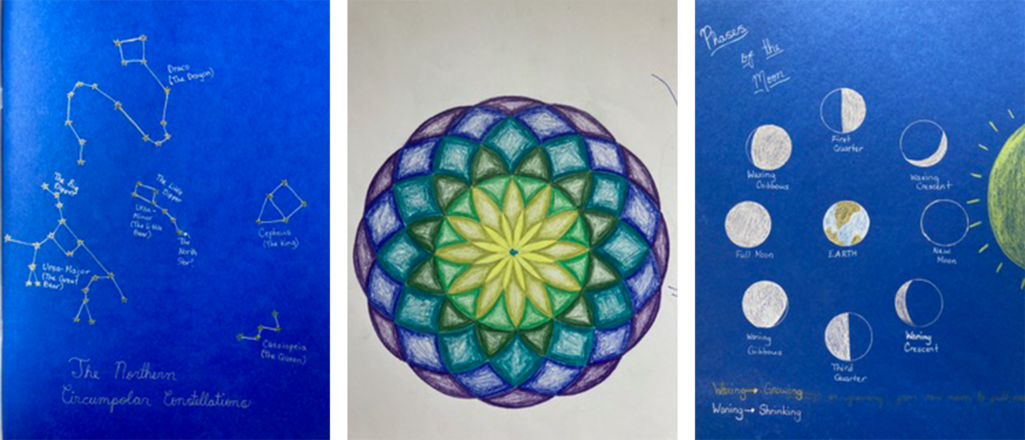
Alum Spotlight: Jason Piperberg - Illustrating Dreams into Reality
 Jason Piperberg
Jason Piperberg
Class of 2004
Meet Jason Piperberg, an accomplished illustrator and comic artist whose journey from the halls of Susquehanna Waldorf School to the vibrant streets of Philadelphia has been nothing short of inspiring. Jason's artistic prowess and dedication to his craft have led to collaborations with renowned artists, making his mark in the world of comics and illustration.
Early Roots at SWS:
Jason's passion for art and comics was sparked at Susquehanna Waldorf School (SWS), where his journey began in the 4th grade. His desire to become a professional artist and delve into the world of comics took shape, supported by the Waldorf curriculum The process of illustrating Main Lesson books (now called Morning Lesson books) was pivotal, establishing the foundation for his future endeavors.
"My favorite part of the Main Lesson books was making the illustrations for what we were learning about, and that's essentially what I do now, every day," Jason reflects on his time at SWS.
From SWS to the University of the Arts:
After graduating from SWS in 2004, Jason continued his educational journey at The University of the Arts in Philadelphia, a city that has become a significant part of his life. Philadelphia provided the backdrop for his college years, and the city's vibrant atmosphere sparked his creative spirit.
Artistry in Motion:
Since graduating from The University of the Arts in 2012, Jason has doggedly pursued his artistic dreams. He has stackled diverse projects, showcasing his versatility and creativity. Notable accomplishments include working on posters for the Philadelphia Eagles, contributing to Archie Comics' Sonic Universe and Mega Man titles, and creating all the art and book layout for the comic that was then made into the Netflix show Raising Dion.
Current Comic Projects:
Jason is currently immersed in three exciting comic projects, "My Neighbor Necromancer," a YA horror/adventure comic, and "Binary Sea," a captivating blend of Pirates of the Caribbean, Star Trek, and Master and Commander. Both demonstrate his storytelling finesse. The third project, "Doctor Livewell," tackles a unique theme – abdominal pain – and is a collaboration with Dr. David Suskind, a pediatric gastroenterologist.
Waldorf-Inspired Creative Process:
Jason's creative process begins with rough thumbnail sketches, and evolves into intricate line work and vibrant colors. While he acknowledges the absence of explicitly Waldorf-inspired elements in his process, he believes that the essence of his SWS education provided a firm foundation and continues to influence his approach.
Reflecting on SWS:
Looking back on his time at SWS, Jason credits the school for honing his ability to translate words into visual art, a skill that is crucial in his work today. Despite initially feeling different in the larger high school setting, his Waldorf background and the presence of other Waldorf graduates helped him navigate the transition and find lasting friendships.
Advice for SWS Students:
As Jason imparts wisdom to current SWS students embarking on their journeys, he emphasizes the inevitability of change. "Be aware that things always change," he advises. Jason encourages students to embrace the evolving phases of life, learn from challenges, and find their own pace.
In the dynamic world of illustration and comics, Jason Piperberg stands as a testament to the transformative power of passion, education, and the unique journey each individual embarks upon. His story is inspiring for budding artists, illustrating that early interests, gifts and dreams nurtured in the classrooms of Waldorf education can indeed flourish into remarkable careers.
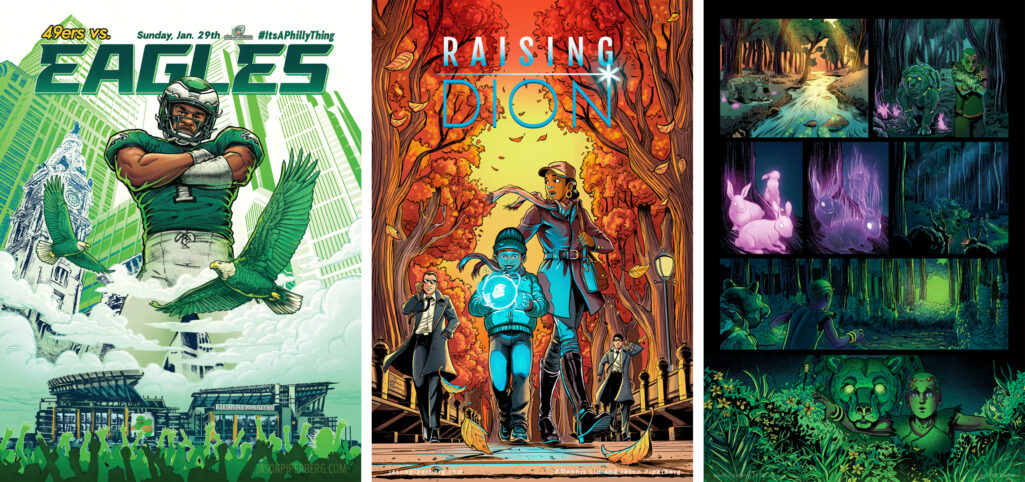
See more of Jason's work at: https://jasonpiperberg.com/
Montessori and Waldorf Education: Comparing Two Unique Approaches to Learning
Choosing the right educational philosophy for your child is a crucial decision. Two independent school alternatives often considered by parents are Montessori and Waldorf education. These two approaches share certain foundational principles, such as child-centered learning and fostering independence, but their distinct differences can directly impact a child's educational experience. In this blog post, we'll explore how Montessori is similar to and differs from Waldorf education to help parents gain greater insight to make an informed decision for their child’s educational journey.
Montessori Education:
Maria Montessori's educational philosophy is centered around the idea that children have an innate desire to learn. Montessori classrooms are prepared with carefully designed materials encouraging hands-on, self-directed learning.
Key Features of Montessori Education:
- Individualized learning: Montessori education emphasizes individualized learning, allowing each child to progress at their own pace. This approach helps children develop a strong sense of autonomy and responsibility.
- Freedom within limits: Students have the freedom to choose their activities but within defined boundaries. This balance helps foster discipline and self-regulation.
- Specific learning materials: Montessori classrooms are equipped with specialized materials that encourage children to explore and experiment, promoting cognitive and motor skill development.
Waldorf Education:
Waldorf educational philosophy, founded by Rudolf Steiner, provides a holistic approach to learning and emphasizes creativity, imagination, and artistic expression. Waldorf education offers a unique approach that values the development of the whole child – mind, body, and spirit. It prioritizes creativity and a deep connection to the natural world. The gradual introduction of technology and the focus on storytelling and the arts in Waldorf education fosters a strong sense of wonder and a love for learning.
Key Features of Waldorf Education:
- A focus on imagination: Waldorf education encourages children to live deeply into imagination and creativity through activities such as storytelling, art, and music. This provides the foundation for creative problem-solving, artistic appreciation, and higher-order conceptualization.
- Morning Lesson Blocks: Grades students engage in extended "morning lesson blocks," delving deeply into academic subjects over a period of several weeks. This approach allows students to immerse themselves in the topic, allowing for deeper understanding and recall. Paired with the morning lesson block, students also have classes in foreign languages, music, handwork, and other special subjects.
- Minimal Use of Technology: Waldorf schools typically limit the use of technology in the early years, promoting a sensory-rich and experiential approach to learning. Waldorf philosophy fosters a strong bond between teachers and students unimpeded by technology in the early years. The Waldorf philosophy indicates a way for students to learn through imitation, imagination, and experiential exploration.
Similarities and Differences:
While Montessori and Waldorf education may seem different in their approaches, they do share some similarities:
- Child-Centered: Both philosophies put the child at the center of their educational experience, valuing the unique needs and interests of each student. Waldorf Education also places a heavy emphasis on the child and family as part of a learning community.
- Hands-On Learning: Both encourage experiential, hands-on learning, though the materials and activities differ. Waldorf Education emphasizes an integrated arts approach rather than art as a separate subject (as in Montessori).
- Teacher as Guide: In both Montessori and Waldorf education, teachers serve as guides and facilitators rather than authoritative figures. Waldorf teachers often stay with their class for multiple years, some 1st through 8th grade.
When choosing between Montessori and Waldorf education, parents must consider the individual needs and personality of their child. Both approaches have their merits and can provide a rich educational experience. Waldorf education, with its emphasis on holistic development and nurturing creativity, can be a compelling choice for parents seeking a well-rounded educational experience that celebrates the individuality of their child within a supportive community.

























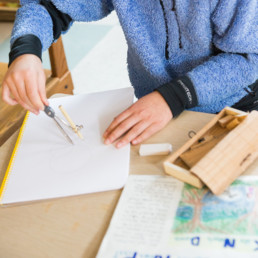

 Jason Piperberg
Jason Piperberg